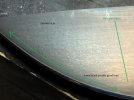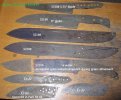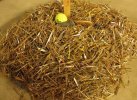Yes, the inclusions aligned in the direction of rolling are the reason for the different properties in different directions (anisotropy) that cause the "grain" in steels and other rolled metal products. I'll have to reread the section in my reference. It seems to have a slightly different meaning there, or those are more specific in the references you listed. It may be possible that I'm using it incorrectly, and will have to change again. Oh, and the inclusion most commonly discussed are the MnS stringers, which are in the grains, not around them.
-
The BladeForums.com 2024 Traditional Knife is available! Price is $250 ea (shipped within CONUS).
Order here: https://www.bladeforums.com/help/2024-traditional/
You are using an out of date browser. It may not display this or other websites correctly.
You should upgrade or use an alternative browser.
You should upgrade or use an alternative browser.
Super quenched 52100 knife
- Thread starter BluntCut MetalWorks
- Start date
- Joined
- Mar 7, 2001
- Messages
- 4,608
What is MnS and the meaning 'in the grain'?
BluntCut MetalWorks
Knifemaker / Craftsman / Service Provider
- Joined
- Apr 28, 2012
- Messages
- 3,464
My guess 
MnS = Maganese + Sulfur
Mn & S can/probably segregated/clumped/distributed along grain boundary, so mechanically stretch will elongate/stringer along with grain elongation.
Jason, After carefully looked at your A2 knife pic, I think the pattern came from decarburized layer and factory blade profile grind lines (very coarse wheel grinder). They didn't clean all that up with final grinding belt. Higher surface probably more decarb, hence more Cr available to resist etching, thus look brighter.

MnS = Maganese + Sulfur
Mn & S can/probably segregated/clumped/distributed along grain boundary, so mechanically stretch will elongate/stringer along with grain elongation.
Chris "Anagarika";13507710 said:What is MnS and the meaning 'in the grain'?
Jason, After carefully looked at your A2 knife pic, I think the pattern came from decarburized layer and factory blade profile grind lines (very coarse wheel grinder). They didn't clean all that up with final grinding belt. Higher surface probably more decarb, hence more Cr available to resist etching, thus look brighter.

Whoops. Pretty vague, there wasn't I? MnS is manganese sulfide. It is an inclusion that forms in the grain interior, vs around the grain boundary. Mn is added to steel in part to control sulfur. If its not added and sufficient sulfur is present, it combines with iron and forms FeS. FeS forms around grain boundaries and has the unfortunate property of a low melting point. So, at forging and hot rolling temperatures, you have this FeS surrounding the grains and then melts. You can see where this would cause some issues.
Jason B.
Knifemaker / Craftsman / Service Provider
- Joined
- Jun 13, 2007
- Messages
- 11,196
My guess
MnS = Maganese + Sulfur
Mn & S can/probably segregated/clumped/distributed along grain boundary, so mechanically stretch will elongate/stringer along with grain elongation.
Jason, After carefully looked at your A2 knife pic, I think the pattern came from decarburized layer and factory blade profile grind lines (very coarse wheel grinder). They didn't clean all that up with final grinding belt. Higher surface probably more decarb, hence more Cr available to resist etching, thus look brighter.
View attachment 437971
There is not a single factory grind mark left on the blade. The only marks are from the sandpaper I used in grits of 400 and 1000 prior to etch and I don't sharpen parallel to the edge so the pattern you see is actually intersecting my grind lines at 90 degrees.
From how I'm reading it the fibering that I (we) are seeing in the etch could very well be considered looking at the grain of the steel but in more of a zoomed out view. Like looking at the wood grain of fresh cut lumber it's easy to see the direction of grain but you cannot see the cell structures between the lines of the wood grain. So, just like the terminology for lumber the fibering is just like wood fibers, it's long chains of crystals held together between inclusions.
- Joined
- Mar 7, 2001
- Messages
- 4,608
This thread has been very educational! Thanks to all!
There is not a single factory grind mark left on the blade. The only marks are from the sandpaper I used in grits of 400 and 1000 prior to etch and I don't sharpen parallel to the edge so the pattern you see is actually intersecting my grind lines at 90 degrees.
From how I'm reading it the fibering that I (we) are seeing in the etch could very well be considered looking at the grain of the steel but in more of a zoomed out view. Like looking at the wood grain of fresh cut lumber it's easy to see the direction of grain but you cannot see the cell structures between the lines of the wood grain. So, just like the terminology for lumber the fibering is just like wood fibers, it's long chains of crystals held together between inclusions.
Sometimes it's possible to see coarser scratch remnants if the blade is etched. These are not scratches, but when abrasive, particularly coarse abrasive, cuts steel, there is an effect that is deeper than the scratch. Sometimes this can be seen if it's not removed with successive grit steps, and it can be surprisingly deep depending on how coarse and how aggressive the grinding was.
That's sort of it. What you are seeing are not the steel grains, but inclusions that have been elongated. The grains are elongated too, but reform (recrystallize) at hot rolling and forging temperatures. The MnS is ductile and will deform in the rolling direction, or direction of plastic flow when forged. Harder and brittle inclusions like carbides, nitrides, oxides, etc are not deformed, but are reoriented in the direction of rolling/forging. Better steel production reduces the amount of inclusions, but in commercially viable steel, there are always some present. Nearly all domestically made steel in the USA is fully aluminum killed, which means aluminum is used to bond oxygen dissolved in the liquid steel. Some nitrogen is also typically present, and the aluminum bonds with that as well. The particles are extremely fine and are beneficial in some ways, unless there is too much for the application.
My guess
MnS = Maganese + Sulfur
Mn & S can/probably segregated/clumped/distributed along grain boundary, so mechanically stretch will elongate/stringer along with grain elongation.
Jason, After carefully looked at your A2 knife pic, I think the pattern came from decarburized layer and factory blade profile grind lines (very coarse wheel grinder). They didn't clean all that up with final grinding belt. Higher surface probably more decarb, hence more Cr available to resist etching, thus look brighter.
View attachment 437971
I was under the impression that BRKT ground their knives after heat treat, thus removing any decarb layer. Are they doing it different now?
BluntCut MetalWorks
Knifemaker / Craftsman / Service Provider
- Joined
- Apr 28, 2012
- Messages
- 3,464
You're right me2, no decarb layer - Now, I remember Mike Stewart said they always post ht grind.
Per Jason pic, I don't think the pattern from mechanical stringer nor fiber because the pattern vector curved along the edge. Which why I believed those were from grind lines (or perhaps sub-scratch-surface burnished from very coarse abrasive).
Per Jason pic, I don't think the pattern from mechanical stringer nor fiber because the pattern vector curved along the edge. Which why I believed those were from grind lines (or perhaps sub-scratch-surface burnished from very coarse abrasive).
I was under the impression that BRKT ground their knives after heat treat, thus removing any decarb layer. Are they doing it different now?
BluntCut MetalWorks
Knifemaker / Craftsman / Service Provider
- Joined
- Apr 28, 2012
- Messages
- 3,464
I just super quenched - two CruforgeV & an 8" 52100 knives. In this video, you can see a little bit of the red-color on the 52100 blade before quench. After a quick Cryo dip, they are tempering now.
Thanks for watching & comments.
[video=youtube_share;6uNmaJCVQDU]http://youtu.be/6uNmaJCVQDU[/video]
Thanks for watching & comments.
[video=youtube_share;6uNmaJCVQDU]http://youtu.be/6uNmaJCVQDU[/video]
- Joined
- Mar 7, 2001
- Messages
- 4,608
I just super quenched - two CruforgeV & an 8" 52100 knives. In this video, you can see a little bit of the red-color on the 52100 blade before quench. After a quick Cryo dip, they are tempering now.
Thanks for watching & comments.
[youtube]6uNmaJCVQDU[/youtube]
Waiting for the tempering & test. So far no ping & crack heard, so it's encouraging!
Last edited:
BluntCut MetalWorks
Knifemaker / Craftsman / Service Provider
- Joined
- Apr 28, 2012
- Messages
- 3,464
Well, the 8" 52100 knife shown in the video is in 2 pieces. Looking back, the warp I mentioned in the video, caused by an accidental spot-water-quenched (ehem water on the quench plates), warped & a surface crack (1mm deep x 8mm long). After a quick tempered, it broke into 2 pieces when I try to straighten it with clamps. Quite upsetting at my poor execution, I prepared 2 more 8.5" 52100 blanks. So instead of 4 knives, I end up with 8 knives for this weekend. They are all tempered now. The 8" gyuto & 5.75" petty need a minor straightening. Too bad, I didn't video the last 4 knives because after I added more water & soap to my super quench. My boy felt the ground vibration & air waves from super quench 4 ft away.

So far from file+rub+sand pulse-check, all knives passed the pulse tests. Early gut instinct tell me that CruforgeV will out perform 52100 - beside CruV 0.75% of Vanadium - am talking about even finer grain and stronger microstructure. However if cruV end up to be too difficult in sharpening, then it would be a deal killer. Now, I've to find some creative way to squeeze some time during a work week to grind these knives

So far from file+rub+sand pulse-check, all knives passed the pulse tests. Early gut instinct tell me that CruforgeV will out perform 52100 - beside CruV 0.75% of Vanadium - am talking about even finer grain and stronger microstructure. However if cruV end up to be too difficult in sharpening, then it would be a deal killer. Now, I've to find some creative way to squeeze some time during a work week to grind these knives
Chris "Anagarika";13521849 said:Waiting for the tempering & test. So far no ping & crack heard, so it's encouraging!
- Joined
- Jan 6, 2005
- Messages
- 9,680
Buddy... if we were face to face, I would hand you a beer while saying this as a reassurance that my intentions are sincere(FYI, beer=sincerity in my world)...
Stop the bleeding. You can't possibly think that you are onto something that is defying metallurgical principle. Stop destroying good steel based on a few seemingly successful cutting tests. Notice, there are only 3 main posters in this thread? Nobody wants to touch it. Sincerely, do yourself a favour and run this through a metallurgical forum like hypefreeblades.com
Stop the bleeding. You can't possibly think that you are onto something that is defying metallurgical principle. Stop destroying good steel based on a few seemingly successful cutting tests. Notice, there are only 3 main posters in this thread? Nobody wants to touch it. Sincerely, do yourself a favour and run this through a metallurgical forum like hypefreeblades.com
BluntCut MetalWorks
Knifemaker / Craftsman / Service Provider
- Joined
- Apr 28, 2012
- Messages
- 3,464
Rick, I probably need a dump from a tub of cold beer to wake me from delusion of grandeur dream - thanks for your sincerity & not mincing words.
I shouldn't have bought that Baryonic Sequencing Vortex Collimator on fleebay - now I unfolded the label to clearly see that said for 'mental' uses, not 'metal' :beaten:
I shouldn't have bought that Baryonic Sequencing Vortex Collimator on fleebay - now I unfolded the label to clearly see that said for 'mental' uses, not 'metal' :beaten:
Buddy... if we were face to face, I would hand you a beer while saying this as a reassurance that my intentions are sincere(FYI, beer=sincerity in my world)...
Stop the bleeding. You can't possibly think that you are onto something that is defying metallurgical principle. Stop destroying good steel based on a few seemingly successful cutting tests. Notice, there are only 3 main posters in this thread? Nobody wants to touch it. Sincerely, do yourself a favour and run this through a metallurgical forum like hypefreeblades.com
BluntCut MetalWorks
Knifemaker / Craftsman / Service Provider
- Joined
- Apr 28, 2012
- Messages
- 3,464
I want to know - just a quantity for this particular setup - when this knife would no longer able to slice newsprint. Stop when 25% of the edge will just tear newsprint. I decided to post this result FWIW (laugh & wink expected  ).
).
Cardboard shred stats - mostly cross ridge/wall cuts
Knife: Aldo 52100, 4" blade, 9" OAL, super quenched, 64rc, quilted zebrawood handle. Thickness: 0.032" @1/4" from edge; 0.042"@ 1/4" from tip; 0.125" @above heel.
Cut time: 5 to 6 hrs spanned over 2 weeks. No touch up nor sharpen, just occasional a few swipe/strop on cardboard to clean up glue on edge.
Total weight (of cut strips): 105 ounces
Avg strip width: 1/10"
Linear cut length calculation on a piece of 5/52 x 10 x 12" (1.6 ounce) = ~ 100 ft cut per 1.6 ounce.
~ Total linear cut length = (104/1.6) * 100ft = 6500 ft (1.23 mile, 1.98km)
Over view

Edge view

Cardboard shred stats - mostly cross ridge/wall cuts
Knife: Aldo 52100, 4" blade, 9" OAL, super quenched, 64rc, quilted zebrawood handle. Thickness: 0.032" @1/4" from edge; 0.042"@ 1/4" from tip; 0.125" @above heel.
Cut time: 5 to 6 hrs spanned over 2 weeks. No touch up nor sharpen, just occasional a few swipe/strop on cardboard to clean up glue on edge.
Total weight (of cut strips): 105 ounces
Avg strip width: 1/10"
Linear cut length calculation on a piece of 5/52 x 10 x 12" (1.6 ounce) = ~ 100 ft cut per 1.6 ounce.
~ Total linear cut length = (104/1.6) * 100ft = 6500 ft (1.23 mile, 1.98km)
Over view

Edge view

- Joined
- Jun 4, 2010
- Messages
- 6,642
The Baryonic Collimator is working perfectly...Stay on it.
